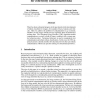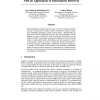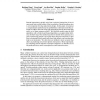103
click to vote
NIPS
2004
15 years 2 months ago
2004
Linear Discriminant Analysis (LDA) is a well-known method for feature extraction and dimension reduction. It has been used widely in many applications such as face recognition. Re...
NIPS
2004
15 years 2 months ago
2004
We consider multi-agent systems whose agents compete for resources by striving to be in the minority group. The agents adapt to the environment by reinforcement learning of the pr...
107
click to vote
NIPS
2004
15 years 2 months ago
2004
We present an extension to the Jojic and Frey (2001) layered sprite model which allows for layers to undergo affine transformations. This extension allows for affine object pose t...
NIPS
2004
15 years 2 months ago
2004
There has been substantial progress in the past decade in the development of object classifiers for images, for example of faces, humans and vehicles. Here we address the problem ...
127
click to vote
NIPS
2004
15 years 2 months ago
2004
We study gender discrimination of human faces using a combination of psychophysical classification and discrimination experiments together with methods from machine learning. We r...
133
click to vote
NIPS
2004
15 years 2 months ago
2004
Directed graphical models with one layer of observed random variables and one or more layers of hidden random variables have been the dominant modelling paradigm in many research ...
95
Voted
NIPS
2004
15 years 2 months ago
2004
Recently, there have been several advances in the machine learning and pattern recognition communities for developing manifold learning algorithms to construct nonlinear low-dimen...
99
Voted
NIPS
2004
15 years 2 months ago
2004
Protein interactions typically arise from a physical interaction of one or more small sites on the surface of the two proteins. Identifying these sites is very important for drug ...
NIPS
2004
15 years 2 months ago
2004
Classification algorithms typically induce population-wide models that are trained to perform well on average on expected future instances. We introduce a Bayesian framework for l...
NIPS
2004
15 years 2 months ago
2004
We propose a family of kernels based on the Binet-Cauchy theorem and its extension to Fredholm operators. This includes as special cases all currently known kernels derived from t...



